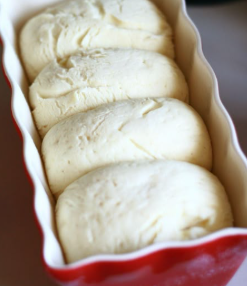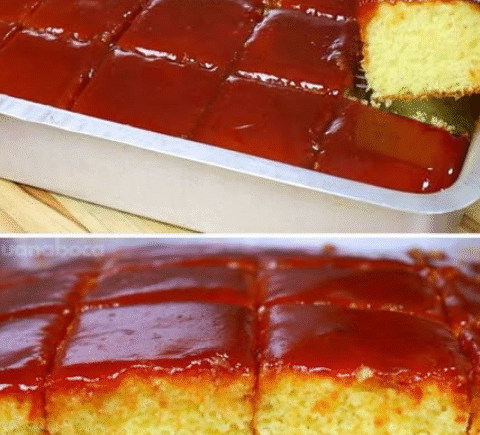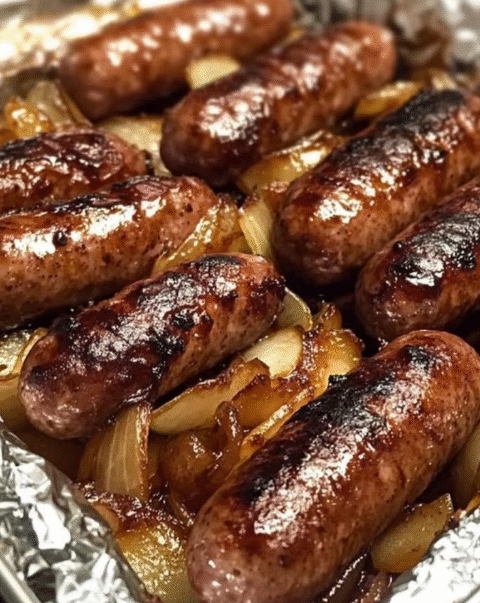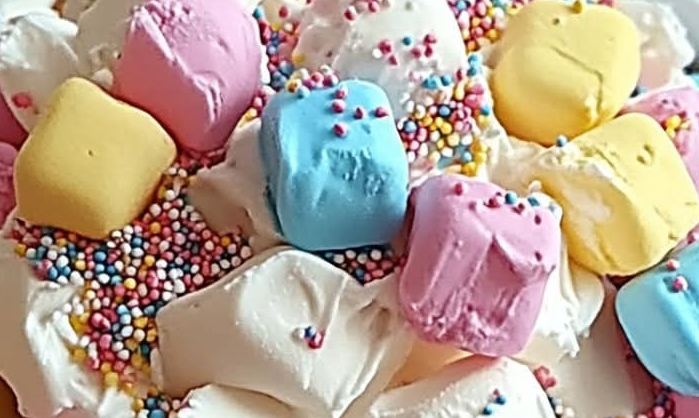Soft Homemade Bread Dough — Fluffy as a Cloud
This is a comforting, simple bread recipe made with basic ingredients. I’ve added a little secret (Tangzhong) that makes the crumb extra soft and fluffy, like what you’d get at a bakery. Perfect for loafs, sandwiches or fresh‑sliced just out of the oven.
—
Ingredients & Measurements
| Ingredient | Amount | Metric | Purpose |
|---|---|---|---|
| All‑purpose flour | 4 cups | ≈ 500 g | Main structure; gluten formation |
| Salt | 2 teaspoons | ≈ 10 g | Flavor, controls yeast activity |
| Sugar | 2 teaspoons | ≈ 10 g | Feeds yeast, helps browning |
| Dry yeast | 1½ tablespoons (or 2 T fresh yeast) | ≈ 15 g dry / 30 g fresh | Leavening |
| Warm water | 1½ cups | ≈ 350 ml at ~98 °F / 37 °C | Hydrates flour, activates yeast |
| Vegetable oil (optional) | 1 tablespoon | ≈ 15 ml | Adds softness, helps crust |
| Secret: Tangzhong (flour + water paste) | Use ~5 tablespoons flour + ~¼ cup water | ≈ 40‑50 g flour + 60 ml water | Locks moisture and keeps bread fluffy longer |
—
What Is Tangzhong? The Secret for Cloud‑Fluffiness
Tangzhong is a technique borrowed from Japanese baking, where you cook a small portion of flour with water (or milk) into a paste or roux‑like gel. This gel, when added to bread dough, helps retain moisture, improve softness, and prolong freshness. :contentReference[oaicite:0]{index=0}
—
Step‑by‑Step Instructions
1. Prepare Tangzhong (optional but HIGHLY recommended)
- In a small pot, mix the tangzhong flour + water over medium heat.
- Stir constantly until it thickens into a paste that holds lines (about when you see it “gelatinize”). Remove from heat and let cool.
2. Mix Dry Ingredients & Yeast
- In a large bowl, combine the flour (reserve the flour used for tangzhong), salt, sugar.
- Activate your yeast: if using fresh yeast dissolve it in a bit of warm water (from the 350 ml), or if dry yeast you can sprinkle it directly over the flour or dissolve it as per your comfort.
3. Add Liquids & Tangzhong
- Add the warm water gradually to the dry mix, plus oil, and the cooled tangzhong paste.
- Mix until it comes together into a dough.
4. Knead
- Knead for about **10 minutes** until the dough is smooth and elastic.
- You can test by windowpane test: stretch a piece of dough thin—if it forms a translucent membrane without tearing, gluten is well‑developed. :contentReference[oaicite:1]{index=1}
5. First Rise (Bulk Fermentation)
- Place dough in a bowl lightly greased with oil, cover with plastic wrap or clean cloth.
- Let rest in a warm place for about **1 hour** or until doubled in size.
6. Shape
- Divide the dough into 4 equal portions.
- Shape each into a loaf: elongate, round off edges, or shape for your preferred style.
7. Second Rise (Proofing)
- Place shaped loaves on an oiled baking sheet.
- Cover again and let rise for another **30 minutes** in a warm place.
8. Bake
- Preheat oven to **392 °F (200 °C)**.
- Bake for about **20‑25 minutes**, or until crust is golden and loaf sounds hollow when tapped on the bottom.
9. Cool & Serve
- Remove from oven and let cool on a wire rack. Cooling helps set the crumb and prevents it from being gummy inside.
- Slice only when partially cooled for best structure.
—
Tips & Tricks to Maximize Fluffiness
- Use **lukewarm water** (around 37 °C) to activate yeast without killing it.
- Don’t add salt directly onto yeast—salt can inhibit yeast if it contacts it directly. Mix salt into flour first. :contentReference[oaicite:2]{index=2}
- Kneading properly: use windowpane test to know when dough is ready. Too little = dense; too much = tough. :contentReference[oaicite:3]{index=3}
- Proofing environment: warm (not hot), draft‑free spot helps. If room is cool, you can turn oven on for a minute then off, leave door open, place dough inside. The mild warmth helps.
- Don’t overproof: letting dough rise too long causes it to collapse. Use “poke test” (finger touch) to test: if dough springs back slowly but leaves a slight indentation, it’s ready. :contentReference[oaicite:4]{index=4}
- Egg wash or brushing lightly with milk or oil before baking produces a softer crust. Optional if you like softer crust.
- Using bread flour (higher protein) gives more gluten strength and usually a lighter, more elastic crumb. If only all‑purpose is available, the Tangzhong helps compensate. :contentReference[oaicite:5]{index=5}
—
Nutrition & Estimates
Here’s an approximate nutritional breakdown per loaf slice (assuming 8 slices per loaf) when using the full recipe (4 loaves), tangzhong, oil, etc. Values will vary depending on your exact brands and portion sizes.
| Nutrient | Per Slice (~1/4 loaf portion if dividing into 4 loaves, each loaf into 8 slices) | % Daily Value* (based on 2,000 kcal) | Notes / Health Info |
|---|---|---|---|
| Calories | ≈ 200‑230 kcal | ≈ 10‑12% | Mainly from flour & small oil; moderate‑calorie bread |
| Protein | ≈ 5‑7 g | ≈ 10‑14% | Flour & yeast contribute; not high protein unless enriched |
| Total Fat | ≈ 2‑4 g | ≈ 3‑6% | Oil plus small natural fat from yeast; very low if oil omitted |
| Carbohydrates | ≈ 40‑45 g | ≈ 13‑15% | Bread is carb‑rich; good energy source |
| Fiber | ≈ 1‑2 g | ≈ 4‑6% | All‑purpose flour has some fiber; using part whole‑wheat boosts fiber |
| Sugar | ≈ 1‑2 g | ≈ 2‑4% | Mostly from the small sugar you added; pretty low |
| Sodium | depends on salt & brands | ≈ 300‑400 mg | Salt gives flavour; adjust if you reduce salt |
* Based on 2,000 kcal/day; your needs might differ.
—
FAQs**
- Do I have to use Tangzhong to get soft bread?
No—you can get good softness without it. But Tangzhong helps retain moisture and softness longer, especially in drier environments or if you want bread that stays soft for more than a day. It’s a helpful “secret,” not strictly required. - Can I use instant yeast instead of dry yeast?
Yes. Instant yeast often works as well or even better. If using instant, you can mix it directly with flour. The proofing times may be a little shorter. - What if my bread comes out dense?
Common causes: not kneading enough (gluten underdeveloped), not enough rise (under‑proofing), water too hot or yeast inactive, or too much flour added. Check those points. - Can I replace part of the flour with whole wheat?
Yes. But whole wheat flour absorbs more water and reduces softness. To keep softness, you might need to increase hydration slightly (more water), use a bit more yeast, and let bread rise longer. - How do I know when it has risen enough?
Use the “poke test”: lightly press with your finger; if the indentation springs back slowly and partially, it’s good. If springs back immediately, it needs more rising. If it stays indented or collapses, it might be over‑proofed. - Why does the crust harden after cooling?
Bread crust will firm up after baking & cooling. If you prefer a softer crust, brush a little oil or butter on top when warm, or cover the bread with a clean cloth during cooling to retain moisture. - Can I bake this bread in other shapes?
Yes. Rolls, buns, braided loaf etc. Just adjust baking time depending on size. Smaller pieces bake faster. - Does using bread flour help?
Yes—bread flour has higher protein, gives more gluten strength, helps trap gas bubbles, yields lighter airy crumb. If available, it’s a good upgrade over all‑purpose. Tangzhong helps especially if you stick with all‑purpose. :contentReference[oaicite:6]{index=6} - What if my kitchen is cold?
Yeast works more slowly in cooler temps. You may extend rise times. For proofing, place dough in slightly warmed (not hot) oven, or use a warm water bowl nearby. Warm ambient temp helps good rise. - How should I store leftover bread?
Store in an airtight bag or container at room temperature. For longer storage, freeze slices wrapped. Reheat in toaster or warm oven to regain softness.
—
Conclusion
This soft homemade bread, with its simple ingredients and the special Tangzhong trick, can become your go‑to loaf whenever you want something warm, fluffy, and satisfying. It’s not hard—just give the dough the right care (kneading, proofing, gentle shaping) and the reward will be wonderful cloud‑like slices.
If you want, I can send you this recipe formatted for printing, or with printable photos, or even video steps. Do you want me to send those? Type “YES”.






